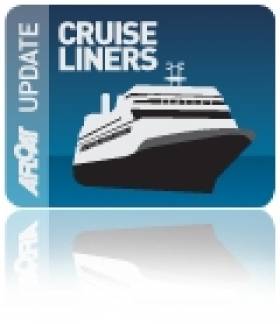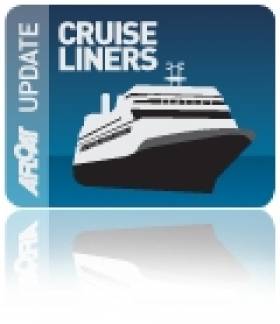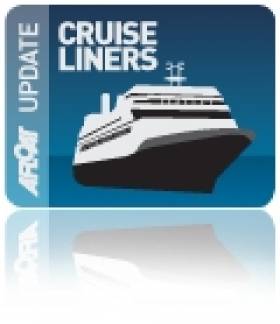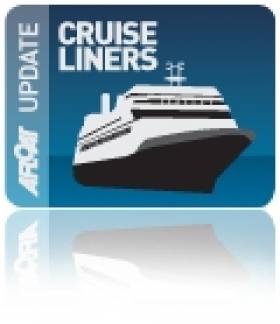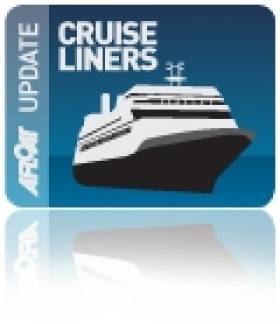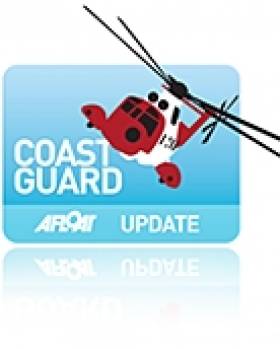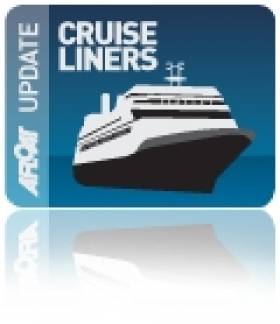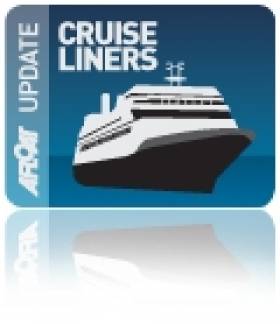Displaying items by tag: Cruise Liners
Cruising By Royal Appointment
#CRUISELINERS- She may be one of the smallest cruiseships operating, however Hebridean Princess (1964/2,112grt) which is to call to Dublin Port this evening, is big in terms of her status, writes Jehan Ashmore.
A plaque was unveiled on board in May to recognise that the ship has been granted a Royal Warrant by Queen Elizabeth II, as the Royal Family chartered the 5-star luxury vessel in Scottish waters in 2006 and 2010.
The warrant for the provision of cruise holidays came into effect at the start of this year and her owners Hebridean Island Cruises will be the only travel brand honoured in such a way.
The interiors are modelled on those of a large country mansion, where each of 30 cabin suites are individually decorated in opulent style. This is a far cry to her origins as a humble ferry. In that guise she ran as Columba, serving ferry operator Caledonian MacBrayne.
This evening she is set to pass through the East-Link toll-lift bridge, due to her smaller dimensions compared to larger cruiseships which have to dock elsewhere in the port. For example today also see 30,000 tonnes sisters Nautica and Azamara Journey dock in Ocean Pier at berths 33 and 37 respectively.
Hebridean Princess is to tie-up on Sir John Rogerson's Quay at berth 8 where she moored last year. In addition this berth was where another equally luxurious vessel the superyacht M.Y. Majestic, which as previously reported called to last weekend. The four-deck Caymen Islands registered vessel is currently on a visit to Dun Laoghaire Harbour.
All Things Nautical As Sisters to Meet On a Journey
#CRUISESHIP SISTERS – Oceania Cruises Nautica (2000/30,277grt) currently docked in Dublin Port will later today be joined by a sister, Azamara Journey, operated by Azamara Club Cruises, writes Jehan Ashmore
Azamara Journey had departed Leith and is heading through the Irish Sea and is expected to arrive in the capital port around mid-afternoon.
Both vessels (circa 680 passengers) form part of an original eight-strong sister fleet of French built 'R' class ships ordered for Renaissance Cruises, which ceased trading in 2001, resulting in the splitting of the ships to various owners.
Incidentally Oceania Cruises also operate two more such sisters. Regatta built as R Five and Insignia, the former R1, the lead-ship of the series all having the previous owner's rather simplistic naming theme. Likewise Azamara Club Cruises operate the former R Seven, rechristened Azamara Quest.
Another 'R' class sister operating for P&O Cruises, the Adonia, which led the seven-strong spectacular sail-past in Southampton waters for the 'Grand Event' to celebrate the 175th anniversary of the famous company, is due to call to Foynes in a fortnight's time.
Noting that Adonia, led the liner line-up which included Arcadia (as previously reported), seen third in line astern and where each ship set off on separate cruises as they headed out of the Solent.
‘Signature’ Cruiseship Signs-In
#SIGNATURE CRUISESHIP – Cruiseship Mein Schiff 2 made her statement with a strikingly refreshing bold livery scheme as she swept across Dublin Bay last evening. Rather than the all too common all-white painted cruiseships, her looks also cut a dash today while visiting Cobh, writes Jehan Ashmore.
Her name is repeated in huge joined-up writing and accompanied by electric-blue coloured words emblazoned across the 262m long 956 passenger capacity vessel. The dynamic livery scheme reaches above the lifeboat deck, leaving the rest of the accommodation superstructure typically painted in white and her German operator, TUI who are represented by a red symbol positioned on the funnel casing.
Mein Schiff 2 measures 77,302 tonnes and the Century-class ship was commissioned for Celebrity Cruises as the Mercury in 1997 from the Meyer Werft shipyard in Papenburg.
This evening she sets sail for the Channel Islands to anchor offshore of St. Peter Port, the capital of Guernsey.
Superyacht Makes A 'Majestic' Entrance
#SUPERYACHT – The elegant streamlined luxury 60m/200ft motoryacht M.Y. Majestic is to dock in Dublin’s Port this evening, having departed Norway via Scottish waters, writes Jehan Ashmore.
The Caymen Islands registered 12-guest charter-yacht (view gallery) which has a crew of 15 to serve clients normally in the warmer climes of the Caribbean and Mediterranean.
On her visit to Dublin she is to moor midway alongside Sir John Rogersons Quay in the heart of the 'Docklands' quarter.
The motoryacht has a skylounge, which offers private vantage point for bird’s eye views. From here guests have the option to convert the lounge into a cinema with a 100-inch screen and a choice of more than 800 on-demand movie titles.
She was built in 2007 by Feadship, the same Dutch yard that completed the M.Y. Air which called to Cork in May. Majestic has two VIP staterooms, in which the stateroom on the lower deck takes up the full beam (10.9m/34ft) and is approached by its own guest lounge. The other accommodation is for five double en-suite cabins.
As to be expected of the millionaires’ yacht, there is an extensive array of leisure toys on board, be it through the use of two tenders (over 23ft), 3-man wave-runners, hobie kayaks, waterskis, wakeboards, scuba equipment facilities for 8 persons and for those snorkelling up to 12. All this is backed up by a Zodiac rescue boat, however for those not wanting to get their feet wet there’s the gym!
She is powered by a pair of CAT 3516 engines which generate 2000hp (1492kw) each, which deliver a cruising speed of 14knots, though if required this can increased to 16 knots.
Chartered Cruiseships Gather for Olympic Games
#OLYMPIC CRUISESHIPS - Peter Deilmann's cruiseship Deutschland (1998/22,496grt) which called to Dublin Port at the weekend is en-route in the English Channel, having departed Plymouth bound for London, where she is set to became a floating hotel during the Olympic Games, writes Jehan Ashmore.
With less than four days to go to the start of the games, the 480 passenger capacity cruiseship has been chartered by the German Olympic Sports Federation. The vessel is scheduled to dock in West India Docks at the foot of the towering banking HQ offices in Canary Wharf.
Last year she made a trial visit, where she became the largest ever vessel to enter through the West India Dock lock. So with her return, she joins Fred Olsen Cruise Lines 929 passenger Braemar (1993/24,344grt) which as previously reported on afloat.ie is also on charter during the sporting spectacle, to the London Organization Committee of the Olympic and Paralympic Games (LOCOG).
The Bahamas-flagged vessel, formerly launched as Crown Dynasty for Crown Cruise Line, is moored in the East London Dock's Albert Dock basin at a berth facing opposite to the runway of London City Airport.
Astern of this vessel is Gemini (1992/19,093grt) which by coincidence is her sistership, having served as Crown Jewel, as both cruiseships were ordered by Crown Cruise Line from the Spanish shipyard of Union Naval de Levante in Valencia. However since change of ownerships, the Braemar was lengthened for her current operator.
As for Gemini likewise, she too has been chartered to LOCOG to accommodate personnel over the course of the games.
Tomorrow Noble Caledonia's 114-passenger Caledonian Sky is due in London too, the former Hebridean Spirit (1992/4,200grt) made a once-only cruise/promo call to Dun Laoghaire Harbour around a decade ago. The large yacht-like vessel will be accompanied by other 'private' luxury motor-yachts during the games, which were last held in the British capital in 1948.
Three’s A Crowd as Liners Line-Up in Dublin
#TREESOME CRUISECALLS – This morning three cruiseships arrived into Dublin Bay and all within less than an hour. Currently the trio are berthed closely together in the centre of Dublin port, which this year expects to see around 90 such vessels visiting this season, writes Jehan Ashmore.
First to arrive was Holland America Line's Prinsendam (1988/37,983grt) from Liverpool, followed by Swan Hellenic's Minerva (1996/12,449grt) from Portsmouth and lastly Peter Deilmann's Deutschland (1998/22,496grt) from Douglas.
In 2011 around 200 large cruise vessels visited Irish shores carrying more than 308,000 passengers and crew. The cruise sector in fact has doubled in terms of visitors, in just over 7 years when 142 cruise ships called in 2004 bringing more than 146,000 passengers and crew.
Large ports such as Dublin, Cork and Belfast handled over 85% of the total cruiseship visitor numbers in 2011. Of these ports only Dublin saw an increase, leaving the others remaining relatively unchanged. However, as previously reported on Afloat.ie, the opening earlier this year of Titanic Belfast is attracting more cruise calls to Belfast.
Woman Airlifted from Cruise Liner in Galway Bay
#COASTGUARD - Galway Bay FM reports that an elderly woman was airlifted by the coastguard from a cruise liner in Galway Bay yesterday morning.
It's believed that the passenger was experiencing cardiac problems.
The woman is a passenger on the Marco Polo, the 800-passenger cruise vessel that was recently anchored in Bantry Bay, as previously reported on Afloat.ie.
Her condition was assessed on board by paramedics before she was taken to Galway University Hospital by the Shannon-based Irish Coast Guard rescue helicopter.
Bantry Bay's Double Role on Display
#CRUISE LINERS – Cruise & Maritime Voyages Marco Polo (1965/22,080grt) anchored off scenic Glengariff today and also sharing Bantry Bay is the tanker Amundsen Spirit (2010/109,290dwt), writes Jehan Ashmore.
The 800-passenger Marco Polo had sailed from Cork and the veteran vessel by coincidence has a deck named Amundsen Deck (etc).
The authority responsible for shipping traffic is Bantry Bay Harbour Commissioners, where the seasonality of the cruise callers visiting West Cork is offset by the year-round business of tankers.
Large tankers can be handled in the deep waters off the Bantry Bay Terminal on Whiddy Island. However the terminal has no jetty facilities, instead tankers use the single-point mooring (SPM) a buoy that is anchored offshore. This system also performs in unloading cargo that is transferred through pipes feeding into the tank farm located on the island.
The tugs Ocean Bank and Trojan were attending the Amundsen Spirit (249m long X 44m beam X 14.6m draft), noting at the bow she a structure to facilitate the SPM operations.
#CRUISE LINERS – This year Belfast Harbour can look forward to a boost in the cruise sector as more than 40 calls are scheduled during the season, the increase is largely attributed to the opening of the iconic visitor attraction of Titanic Belfast, writes Jehan Ashmore.
In 2012 the port is to see an impressive 32% increase on last year with 41 cruise ships bringing almost 75,000 visitors to the port compared to 2011 where 32 ships called with 58,000 passengers.
The ports cruise facility at Stormont Wharf, which cost £10m, continues to pay dividends with its advantage of accommodating large cruise ships operating in the Irish Sea. The wharf at 1km in length is the longest deep-water berth on the island of Ireland.
Among this season's cruise operators visiting the harbour are Cruise & Maritime Voyages (CMV), Fred Olsen Cruise Line, Holland America Line (HAL), P&O Cruises, Prestige Cruises, Princess Cruises and Saga Cruises. Click HERE for a list of cruiseships calling to the port.
#P&O 175th ANNIVERSARY – The cruiseship Arcadia (2005/83,781grt) sailed into Dublin Port after an overnight passage from Southampton, where P&O celebrated their 175th anniversary on Tuesday with a spectacular parade of the fleet billed as the 'Grand Event', writes Jehan Ashmore.
Dublin Port is the first port of call since the 2,388 passenger (maximum) capacity Arcadia departed her homeport on a 14-night adult-only round trip cruise to Iceland. She and six cruiseships of the P&O Cruise fleet formed the impressive sail past down the Solent to where they each went their separate ways on cruising intineries.
The Peninsular and Oriental Steam Navigation Company, better known throughout the world as P&O was established in 1837. The famous company's colourful house-flag is flown on the P&O Cruises fleet and P&O Ferries operating out of the UK. The flag is also depicted as the funnel colours of the ferry fleet and incorporates the royal colours of Spain (red and gold) and Portugal (blue and white) which relate to the older traditional colours representing the monarchy.
In 2005 P&O was sold to Dubai based DP World for £3.3 billion, which operates P&O Ferries, while the cruise division was sold off to Carnival UK, a subsidiary of the US owned Carnival Corporation which among its many companies includes Cunard Line. The Arcadia and her fleetmates are under the P&O Cruise brand and the cruiseships also fly the house-flag under license.
The origins of P&O though can be traced as far back to 1815 when Brodie McGhie Wilcox engaged Arthur Anderson to become a ship clerk in his brokerage business in London. The Lime Street based brokerage initially chartered vessels and the business grew so by 1823 Anderson was made a partner to form Wilcox and Anderson. They embarked on a sail-cargo service from London to the Iberian Peninsula.
In 1835 the timber-built passenger and cargoship paddle steamer William Fawcett was chartered from the Dublin and London Steam Packet Company. The 206-tonne vessel gave a top speed of 10 knots, noting that she had two sailing masts fore and aft of the steamer's funnel.
William Fawcett is regarded to be the first ship in the P&O fleet, the steamer with the Irish connection carried the government contract to carry 'mails' to Iberia. The company secured more contracts and rapid expansion to the Orient, where the house-flag reached India, Ceylon, Penang, Singapore, Hong Kong and Australia. This led to many ships built and not just confined to cargoships, notably the liners with passengers travelling Port-Out and Starboard-Home...how POSH indeed!
It was fitting to see Arcadia arrive into a flat-calm Dublin Bay as she entered from the southern approaches off Dalkey Island, where paddle-steamers such as William Fawcett would of sailed past heading for London. Her modern short-sea successor in the form of P&O Ferries ro-pax European Endeavour (2000/ 22,125grt) was also arriving into the bay off the Baily lighthouse from Liverpool.
Arcadia cost £200m to build and when the vessel was laid down at the Fincantieri Cant. Nav. Italiani SpA shipyard in Monfalcone, she was originally the Queen Victoria for Cunard Line. It was however decided that the newbuild would be renamed Arcadia as she was transferred by Carnival to the P&O Cruises brand and given a traditional name.
To read more about the company, the ships and much more visit www.poheritage.com





























